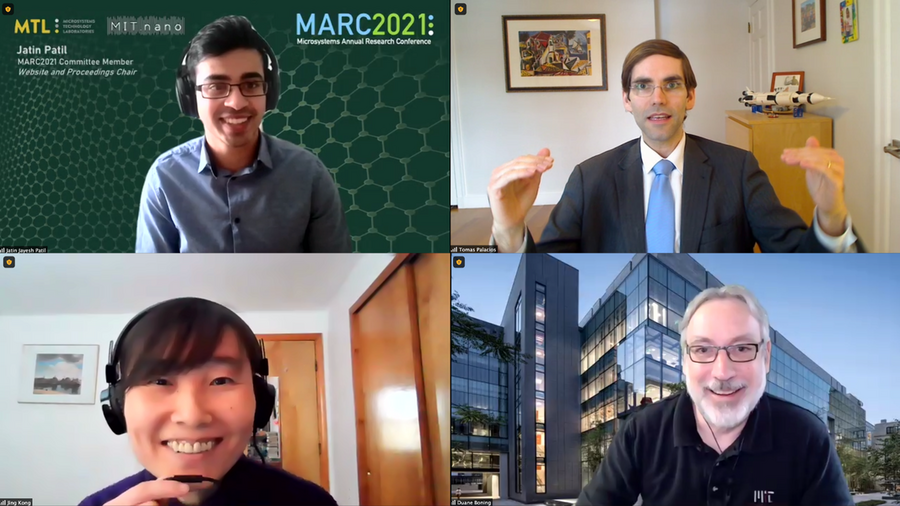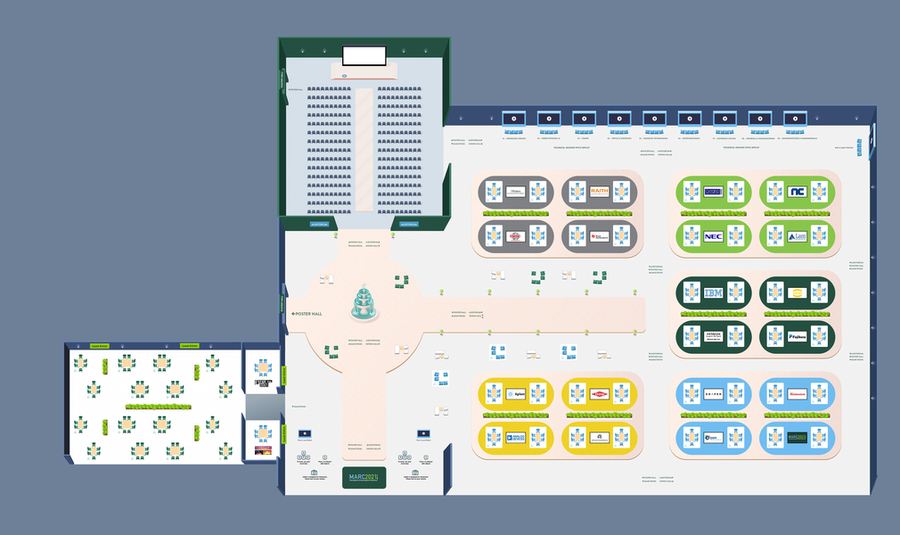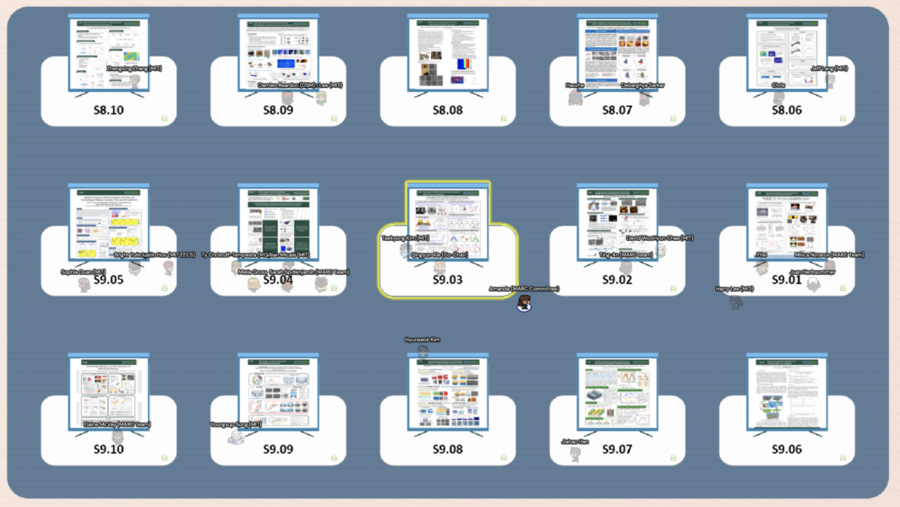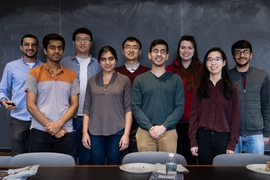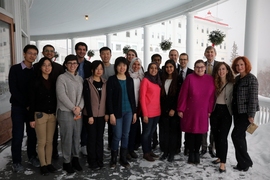For 17 years, the Microsystems Annual Research Conference (MARC) has brought together an audience of over 200 every January for a two-day exploration of research achievements. A gathering that prizes personal interactions as much academic presentations, MARC traditionally takes place in New Hampshire, where skiing, snowshoeing, and social activities intermingle with poster sessions and technical talks.
So, how could the spirit of MARC be preserved during a pandemic, when coming together is not possible?
This was the major challenge faced by MIT student co-chairs Jessica Boles and Qingyun Xie when they met in April 2020 to start planning for MARC 2021, held on Jan. 26–27 and co-sponsored by the Microsystems Technology Laboratories (MTL) and, for the second year, jointly with MIT.nano. The two electrical engineering and computer science (EECS) PhD candidates convened a student committee of 16 individuals who, over 10 months, managed traditional responsibilities such as reviewing abstracts, finding keynote speakers, and organizing social activities, while also navigating new hurdles — the selection of an online platform, concurrent virtual poster presentations, physical and digital distribution of materials, and online networking.
“The events of the past year have shown us that one of the most precious pillars of an organization is the community it fosters,” said Boles and Xie in a letter to this year’s attendees. “When it became clear that a virtual MARC 2021 was our only path forward, our committee was determined to retain the uniqueness and community of MARC at a time when many of us need it most.”
MARC 2021 was held on Gather, an online platform with the look and feel of a retro video game in which attendees use their keyboard to navigate a virtual space as digital characters. Participants could “bump into” other conference goers, sit at virtual tables to eat lunch together, settle into pixelated armchairs for discussion, visit an auditorium with a center stage for lectures, and browse a poster session hall — all reminiscent of a traditional MARC.
The selection and design of this virtual setting was just one of the many tasks accomplished by the student core committee, which broke responsibilities into six categories. Outreach efforts were led by Sarah Muschinske (EECS), conference package logistics by John Niroula (EECS), website and proceedings by Jatin Patil (Department of Materials Science and Engineering), communication training by Nili Persits (EECS), social/networking activities by Kaidong Peng (EECS), and conference platform by Haoquan "Tony" Zhang (EECS).
Keeping attendees engaged was a high priority for the MARC committee — and their efforts proved successful. A record-breaking 327 individuals attended the conference, which was open to MIT students, faculty, and members of MTL’s Microsystems Industrial Group and MIT.nano’s Consortium. MARC 2021 featured 87 student abstracts from over 30 research groups, on par with student presentations from previous years. A networking lunch for students and industry partners — a traditional highlight for the in-person event — saw representation from 12 companies.
A student-run comedy show replaced winter sports. Evening social activities included online games and a virtual escape room. A new series of MIT faculty rap sessions was added this year following each technical block and moderated by a MARC student committee member. To preserve a tangible aspect to the conference, attendees received a package in the mail containing, among other things, a face mask with a nano-silver filter, a chocolate bar featuring the Boston skyline, and a handwritten postcard from the co-chairs. Conference meals were also provided via online ordering.
One benefit of a virtual MARC? Keynote speakers could join from anywhere in the world as long as they had an internet connection. Irwin Jacobs SM '57 ScD '59, founding chairman and CEO emeritus of Qualcomm, opened the conference from California with a fireside chat with MIT PhD student Kruthika Kikkeri about his time working in academia and why he decided to move into the startup world. Jacobs offered words of advice to entrepreneurs thinking about starting their own business.
“You have to have perseverance,” he said. “There are always people who will tell you ‘You can’t do that’ or ‘It doesn’t make sense’ because they don’t want to make changes to what they’re doing, and you might be competing with something that’s ongoing. Find the right people to work with, give them the right environment to work, a lot of elbow room, [and] freedom to come up with new ideas.”
MIT student research was presented over the course of the two days through prerecorded pitches and virtual poster sessions, which were broken into three technical blocks, each containing three research categories. Topics included quantum technologies, power, electronic devices, biotechnologies, energy-efficient AI, nanostructures and nanomaterials, integrated circuits, optics and photonics, and Covid-19. Each category was carefully curated by an EECS graduate student session chair who reviewed abstracts, provided feedback, and ensured all pitch and poster deadlines were met. The 2021 session chairs were Eric Bersin, Benjamin Cary, Nadim Chowdhury, Kruthika Kikkeri, Hsin-Yu (Jane) Lai, Ting-An Lin, Elaine McVay, Rishabh Mittal, Milica Notaros, and Haozhe Wang.
The second day began with a special session featuring lightning talks showcasing technologies being developed at MIT that are applicable to the fight against Covid-19 or similar threats in the future.
Adam Wentworth, research affiliate at the Koch Institute for Integrative Cancer Research, and Sirma Orguc, postdoc with the Institute for Medical Engineering and Science, presented the TEAL respirator — an N95 alternative with a flexible fit and health- and environment-monitoring sensors. Research Laboratory of Electronics postdoc Dohyun Lee discussed rapid monitoring of sepsis using microfluids. Kikkeri, a PhD student in Joel Voldman’s research group, presented an at-home sensing platform that could be used for sensitive and rapid measure of protein biomarkers. Michael Specter, PhD student in the Computer Science and Artificial Intelligence Laboratory, explained SonicPACT, an ultrasonic ranging method for contact tracing and exposure notifications. Finally, PhD students Mantian Xue and Jiadi Zhu, from Tomás Palacios’ research group, presented new bioelectronic sensing technology for fast, accurate Covid-19 screening, and UV-C light for human-friendly sanitizing, respectively.
In their closing remarks, MTL Director Hae-Seung Lee and MIT.nano Director Vladimir Bulović both spoke to the fun, interactive, and enlightening elements of MARC that the students were able to translate to a virtual setting.
“Our success is our community — and MARC 2021 has just demonstrated it,” said Bulović. “Thank you for bringing us together and giving us a chance to exchange the best of our ideas and to strike new friendships that will lead to the next set of great innovations.”
“The scope of the research covered is truly staggering,” said Lee. “Despite all the challenges and concerns during the planning stages of the conference, I believe this year’s MARC far exceeded expectations.”
